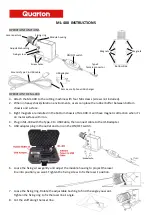
2940 nm Er: YAG
Contour TRL
MicroLaserPeel
(MRL)
ProFractional
Treatment Starting Parameters
APPLICATION
SKIN RESURFACING
ABLATION DEPTH
25 - 100 ΜM
FLUENCE
6.3 - 25 J/CM
2
(DISPLAYED ONLY)
TREATMENT AREA
1.5 - 30%
ProFractional-XC
Treatment Starting Parameters
APPLICATION
ABLATION
DEPTH
COAGULATION
DEPTH
FLUENCE
TREATMENT
AREA
Skin
Resurfacing
and
coagulation
25 - 100
μm
COAG-1
approx. 50 μm
5 - 25
J/cm2
(display
only)
5.5 - 11%
Tissue coagulation is the addition of heat to produce a zone of thermal
necrosis. As an option, Sciton ProFractional-XC device provides three levels
of coagulation:
COAG-1 equals approximately 50 μm
COAG-2 equals approximately 100 μm
COAG-3 equals approximately 150 μm
1.
ProFractional/ ProFractional-XC handpiece should be held perpendicular
to the skin surface at all times. Move patient if necessary to accomplish
this 90 degree angle. The disinfected standoff should be attached to the
handpiece and held in continuous contact with tissue during the entire
treatment for precise focus and uniform delivery of energy.
2.
To confirm that laser and accessories are performing normally, it is useful
for the operator to first test on a nonflammable inanimate object like a
wooden tongue depressor. Treating a test area prior to beginning
treatment will determine the patient’s response threshold and help them
understand the audible and sensory components of the treatment.
3.
Match the trailing edge of one scan pattern to the leading edge of the
next. There should be no overlap between scans. Patterns should “line up”
beside each other.
4.
Patient response can vary. Generally,
treating at deeper depths (higher energy
delivery) and a greater treatment area
percentage (% of skin) both result in greater
efficacy, but also a longer healing time.
5.
Ablation depth and treatment area
percentage should be selected based on
the condition treated, expected outcome,
patient pain tolerance, and expected
downtime for healing after assessing the
individual patient’s needs.
6.
Because skin is thinner on the forehead, it is
recommended that depth and treatment
area percentage settings be more
conservative in that area.
7.
The desired endpoint is erythema within
a few minutes of laser application.
Incidental
pinpoint
to
punctuate
bleeding may occur during the
treatment but usually resolves within a
few minutes to hours after the
completion of treatment. Redness (often
similar in appearance to varying degrees
of sunburn) and healing time will be
greater the deeper the ablation depth,
the greater the treatment area
percentage (% of skin), and with the
addition of COAG and will vary from
patient to patient.
8.
ProFractional/ProFractional-XC pattern
marks are typically very transient and
usually resolve within 2-3 days after
treatment. However, in rare cases this
patterning can be seen for up to 4 weeks
post treatment and usually completely
resolves without intervention.
9.
Particulate debris and blood on the
optics of the scanner and glass plate
standoff may result in laser beam
scattering and an incorrect setting for
fluence. Scanner optics and glass plate
standoff should be cleaned throughout
treatment with a moistened wipe. If
alcohol is used, allow the alcohol to dry
completely before continuing with the
treatment.
Treatment Basics
1.
Patient should be positioned based on the
area to be treated. The position should be
comfortable to the patient and such that the
treatment provider has good access to area
to be treated and the control panel display
screen.
2.
A mild cleanser should be used to remove any
dirt, makeup or moisture from the treatment
site. Wipe the area with an alcohol gauze.
Allow alcohol to evaporate before treatment.
Use special care around the eyes.
3.
If topical anesthetic is to be used, apply as
directed prior to treatment. Before beginning
treatment, ensure that topical has been
completely removed from surface of skin.
4.
Prepare for adequate smoke evacuation
when using a standoff without a sapphire
plate.
5.
Attach clean handpiece with highly
disinfected or autoclaved standoff to
articulated arm.
6.
Enter settings into the control panel display
screen based on condition and area to be
treated
Summary of Contents for JOULE
Page 10: ......




























